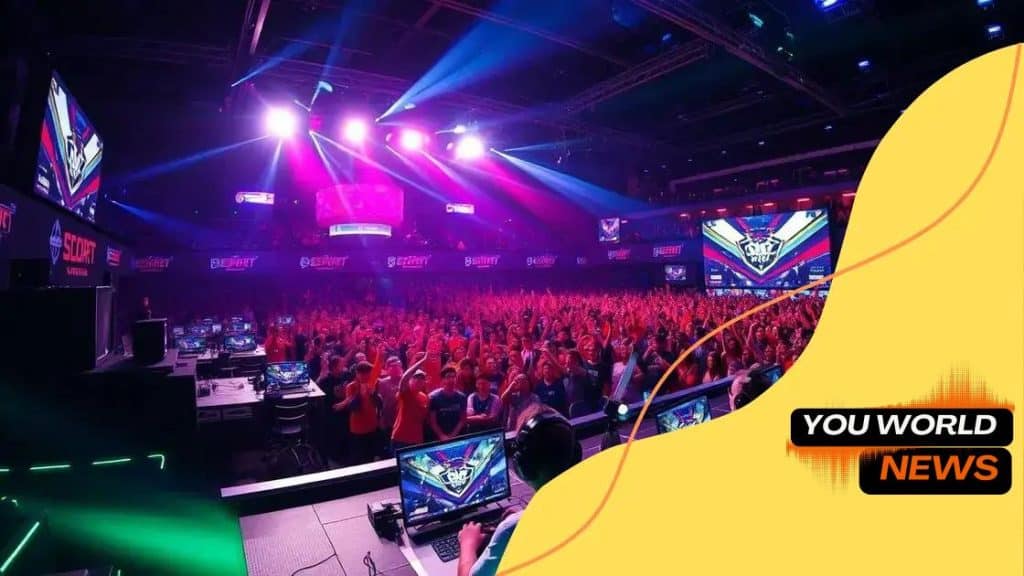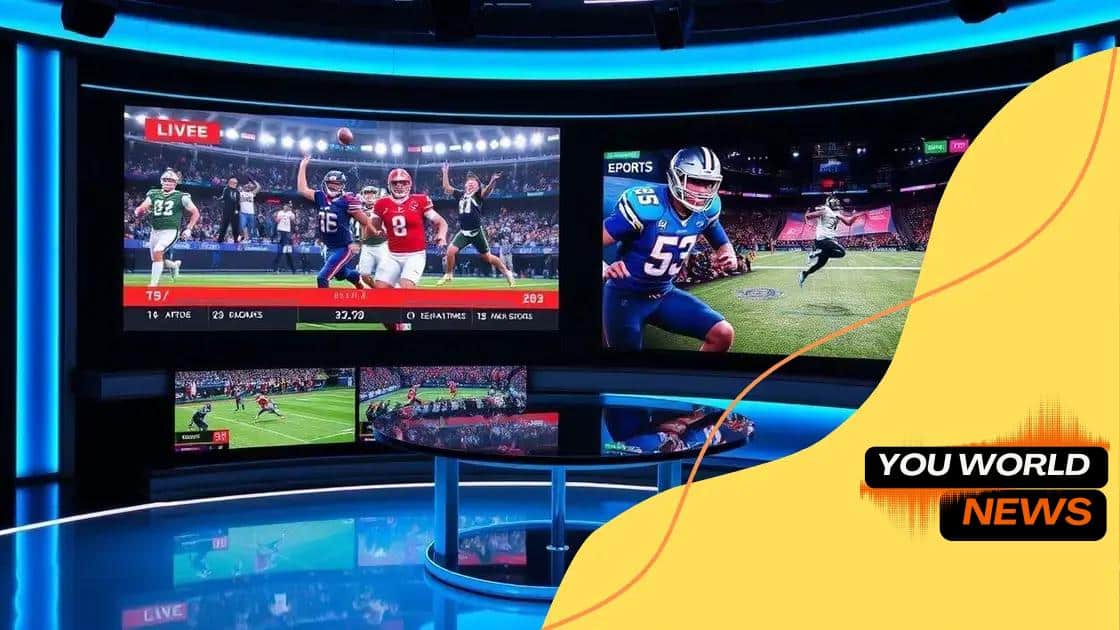How e-sports are influencing mainstream media content

E-sports are significantly influencing mainstream media content by integrating with traditional platforms, enhancing audience engagement, and creating new opportunities for brands to connect with younger demographics through innovative advertising strategies.
How e-sports are influencing mainstream media content is a phenomenon reshaping the landscape of entertainment. Have you noticed how these gaming competitions are no longer just a niche interest but are stepping into the spotlight of mainstream media?
The rise of e-sports in popular culture
The rise of e-sports in popular culture has been nothing short of remarkable. Over the past decade, competitive gaming has transformed from a niche pastime into a global phenomenon. As more people engage with these events, they significantly influence how we perceive entertainment today.
Online platforms like Twitch and YouTube have become hubs for this digital revolution. Gamers worldwide tune in to watch live streams of tournaments where renowned players showcase their skills. This accessibility has played a crucial role in elevating e-sports to mainstream status.
Key Factors Contributing to Popularity
Several factors contribute to the growing acceptance of e-sports:
- Increased audience engagement through live streaming.
- Collaborations with traditional media outlets.
- Corporate sponsorships and advertising investments.
- Overall growth of digital media consumption.
On top of these developments, major brands are recognizing the potential of e-sports as a marketing tool. The partnership between gaming and advertising is creating unique opportunities. Brands engage with younger audiences through innovative campaigns, grabbing attention with tailored content.
Impact on Social Dynamics
The social dynamics around e-sports are also evolving. Fans form communities around their favorite games and players, sharing their experiences on social media platforms. These communities often foster a sense of belonging, inviting newcomers to join the conversation and participate in events.
Moreover, high-stakes competitions attract not just players but also dedicated fan bases. Events like the League of Legends World Championship or the Fortnite World Cup draw millions of viewers, further cementing e-sports’ place in popular culture.
As gaming integrates into schools and universities, it serves as a legitimate avenue for education and career development. More institutions are offering e-sports programs, recognizing its value in career training for aspiring professionals in this fast-growing industry.
In summary, the rise of e-sports in popular culture reflects broader shifts in media and entertainment. As these changes unfold, they pave the way for new opportunities and challenges for both gamers and content creators alike.
How e-sports are changing media consumption habits
How e-sports are changing media consumption habits is a significant shift in the entertainment landscape. Gamers and viewers alike are engaging with content in entirely new ways, influenced by the rise of competitive gaming.
This transformation is evident as more people, especially younger generations, prefer to watch live e-sports events rather than traditional sports. Streaming platforms provide immediate access to gaming experiences, making it easy to find and follow various competitions.
Shift to Viewing Platforms
Many fans now seek content through:
- Twitch and YouTube for live streaming.
- Dedicated e-sports networks and channels.
- Social media for highlights and updates.
This change also affects traditional media. Televised sports networks are partnering with e-sports organizations to attract new audiences, and traditional broadcasters are adapting their strategies. This adaptability opens opportunities for innovative storytelling.
Engagement with Interactive Content
Moreover, e-sports allow viewer interaction in ways that traditional media cannot. Viewers can chat with friends while watching events, participate in live polls, and even influence game outcomes through in-game decisions. This heightened level of interactivity creates a more immersive experience.
As audiences engage more with content tailored to their preferences, e-sports have become a significant factor in shaping media marketing strategies. Brands are eager to tap into this younger demographic, utilizing targeted ads and sponsored content in e-sports broadcasts.
Overall, the changing landscape illustrates a dramatic evolution in media consumption habits, highlighting a shift towards more dynamic, interactive forms of entertainment. As e-sports continue to grow, they hold the potential to redefine how we consume and engage with media across platforms.
The impact of e-sports on traditional sports coverage

The impact of e-sports on traditional sports coverage is a fascinating topic that highlights how the rise of gaming competitions influences established sports media. As e-sports gain popularity, they are changing how traditional sports are viewed and reported.
More sports networks are starting to include e-sports in their programming. They realize that this new audience is ready to embrace both gaming and traditional sports. Viewers now expect to see e-sports alongside their favorite leagues and tournaments.
Integration with Traditional Media
Many sports broadcasters are adapting their strategies to accommodate this change:
- Some networks now air e-sports competitions during prime time.
- Sports analysts are incorporating e-sports into their discussions.
- Collaborations between e-sports organizations and traditional sports teams are becoming common.
This shift not only broadens the audience reach but also enhances engagement. Fans can immerse themselves in both realms while networks cater to diverse interests. The blending of coverage reflects our evolving media landscape.
Changes in Audience Engagement
The way audiences engage with content is also changing. With e-sports, fans interact with games in real-time, influencing how traditional sports leagues engage their viewers. Some leagues are adopting similar interactive strategies, allowing fans to participate through social media and live polls.
Additionally, e-sports have introduced new storytelling techniques. These competitions often feature dramatic narratives and player development, capturing audiences much like traditional sports narratives do. This evolution creates a more compelling viewing experience, attracting younger audiences.
As e-sports continue to grow, their impact on traditional sports coverage will likely expand. This coexistence of gaming and traditional sports can enhance the richness of sports media while introducing fresh perspectives on competitive entertainment. The lines between different forms of sports coverage are fading, creating a dynamic environment for both fans and broadcasters alike.
E-sports as a new advertising platform
E-sports as a new advertising platform is reshaping how brands connect with audiences. With millions of active viewers, this arena offers unique opportunities for businesses seeking to engage younger demographics.
Traditionally, TV and print ads dominated the marketing space. However, e-sports have introduced innovative ways for companies to reach potential customers. The interactive nature of gaming allows for advertisements that feel less intrusive and more integrated into the viewing experience.
Types of Advertising in E-sports
Brands are utilizing various methods to promote their products in the e-sports arena:
- In-game advertisements: Brands can appear within games themselves, such as branded gear or billboards.
- Sponsored tournaments: Companies can sponsor entire events, gaining visibility through promotions and brand recognition.
- Influencer partnerships: Collaborating with popular gamers and streamers helps brands reach their audiences effectively.
- Interactive campaigns: Engaging fans through polls or challenges tied to marketing initiatives fosters community building.
The ability to target a specific audience is another significant advantage. Brands can select specific games or platforms that align with their desired customer profile. As young adults and teens continue to dominate the e-sports viewership, companies are keen to capitalize on these trends.
Effectiveness of E-sports Advertising
Research indicates that advertisements within e-sports events often lead to higher engagement compared to traditional advertising methods. Viewers are more likely to remember brands that they connect with during gaming events. This engagement translates into measurable outcomes, including increased sales and brand loyalty.
As e-sports grow, they remain a vital advertising platform for companies looking to modernize their marketing strategies. The interaction between fans and brands creates opportunities that enhance the overall marketing landscape. By embracing e-sports, brands can effectively tap into the excitement and passion of the gaming community.
Future trends: e-sports and media convergence
Future trends: e-sports and media convergence are paving the way for exciting changes in how entertainment is consumed. The blending of gaming and traditional media is not just a passing trend; it represents a fundamental shift in the entertainment industry.
As e-sports continue to grow, they are becoming a vital part of the broader media landscape. This convergence means that audiences will experience content from multiple platforms in more integrated ways. For example, gaming tournaments are now featured on mainstream television, creating a crossover appeal and attracting diverse viewers.
Integration of Different Media Formats
One of the most significant trends is the integration of various media formats:
- Streaming services: Platforms like Twitch are teaming up with traditional networks to reach wider audiences.
- Virtual and augmented reality: These technologies are enhancing how viewers experience e-sports competitions.
- Social media interactions: Fans engage with live content through real-time chats and polls, creating a community atmosphere.
This ecosystem allows for a richer viewer experience. Fans can watch their favorite teams compete while interacting with other viewers, enhancing the sense of community. Brands and advertisers can leverage this engagement to create targeted campaigns, further blending e-sports with media advertising.
Emerging Technologies and Their Impact
Technological advancements will significantly impact how e-sports content is produced and delivered. High-definition streaming, 360-degree views, and interactive graphics will soon become standard. These features will allow audiences to feel like they are part of the action, making e-sports more compelling than ever.
The rise of mobile gaming also plays a crucial role. As more people access games on their smartphones, e-sports will continue to tap into this growing market. This accessibility can lead to an even wider audience and more opportunities for engagement.
Ultimately, the convergence of e-sports and media will continue to evolve, shaping how viewers consume entertainment. This dynamic landscape opens doors to creativity and innovation, making this an exciting time for fans and content creators alike. The future is bright for both e-sports and traditional media as they learn to coexist and thrive together.
FAQ – Frequently Asked Questions about E-sports and Media Convergence
How are e-sports changing traditional media?
E-sports are being integrated into traditional media platforms, allowing a broader audience to engage with both gaming and sports content.
What impact does technology have on e-sports viewing?
Technological advancements enhance the viewing experience with more interactive and immersive formats, making events more engaging for audiences.
How can brands effectively advertise in e-sports?
Brands can leverage in-game ads, sponsorships, and influencer partnerships to reach targeted audiences, creating organic connections with fans.
What future trends can we expect in e-sports and media?
We can expect continued growth in collaborations between e-sports and traditional media, increased use of augmented reality, and more personalized content experiences.





